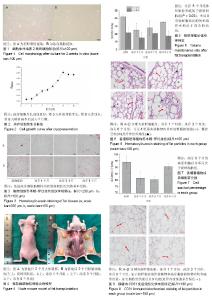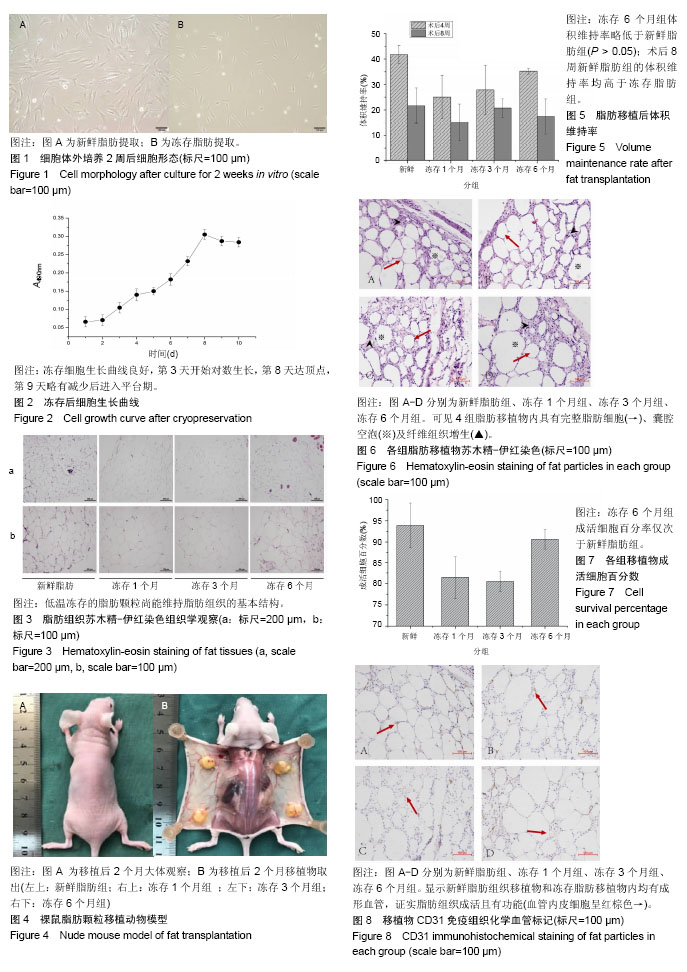| [1] Shu Z, Gao D, Pu LL. Update on cryopreservation of adipose tissue and adipose-derived stem cells. Clinics in plastic surgery. 2015;42(2):209-218.[2] 张广宇,于冬梅,罗赛,等.不同低温条件保存的大鼠脂肪自体移植后成活率的探究[J].中国美容整形外科杂志,2016,27(3):181-185.[3] Coleman SR. Structural fat grafts: the ideal filler?. Clinics in plastic surgery.2001;28(1):111.[4] 仇侃敏,吴蒙,梁耀蝉,等.不同冻存液保存的颗粒性脂肪组织活力及移植成活率分析[J]. 基础医学与临床, 2014,34(4):536-540.[5] 章立群,刘学,任英华,等.大鼠脂肪干细胞冷冻复苏后的生物学特性及成骨细胞分化潜能的研究[J].中国现代医学杂志, 2018(6):33-37.[6] Moscatello DK, Dougherty M, Narins RS,et al. Cryopreservation of human fat for soft tissue augmentation: viability requires use of cryoprotectant and controlled freezing and storage. Dermatologic Surgery. 2005;31(s4):1506–1510.[7] 谢红炬,邓颖,李明,等.自体纯化冷冻微粒脂肪注射移植修复面部皮肤软组织老化性萎缩凹陷[J].中国组织工程研究,2012,16(5):779-782.[8] 逯岩,项艳,张心霞,等.体外冷冻存储脂肪颗粒在隆乳术中的应用[J].中国美容医学, 2012,21(15):1922-1923.[9] MD KTMST. 长期冷冻脂肪的移植[J].中国美容整形外科杂志,2001, 12(6):332-334.[10] 陈静,刘冠兰.冷冻脂肪与新鲜脂肪注射移植的疗效观察[J].中国美容整形外科杂志, 2003,14(3):140-141.[11] Laschke MW, Karschnia P, Scheuer C,et al. Effects of cryopreservation on adipose tissue-derived microvascular fragments. J Tissue Eng Regen Med. 2018;12(4):1020-1030.[12] Zanata F, Bowles A, Frazier T, et al. Effect of Cryopreservation on Human Adipose Tissue and Isolated Stromal Vascular Fraction Cells: In Vitro and In Vivo Analyses. Plast Reconstr Surg. 2018; 141(2):232e-243e.[13] Conti G, Jurga M, Benati D,et al. Cryopreserved Subcutaneous Adipose Tissue for Fat Graft. Aesthetic Plastic Surgery. 2015; 39(5):800-817.[14] Hwang SM, Lee JS, Kim HD,et al. Comparison of the viability of cryopreserved fat tissue in accordance with the thawing temperature. Arch Plast Surg. 2015;42(2):143-149. [15] Shoshani O, Ullmann Y, Shupak A, et al. The role of frozen storage in preserving adipose tissue obtained by suction-assisted lipectomy for repeated fat injection procedures. Dermatol Surg. 2001;27(7):645-647.[16] Zhao G, Liu X, Zhu K,et al. Hydrogel Encapsulation Facilitates Rapid-Cooling Cryopreservation of Stem Cell-Laden Core-Shell Microcapsules as Cell–Biomaterial Constructs. Adv Healthc Mater. 2017 Dec;6(23). [17] Liu X, Zhao G, Chen Z, et al. Dual Suppression Effect of Magnetic Induction Heating and Microencapsulation on Ice Crystallization Enables Low-Cryoprotectant Vitrification of Stem Cell–Alginate Hydrogel Constructs. ACS Appl Mater Interfaces. 2018;10(19): 16822-16835.[18] 刘磊,庸奇,李娜,等.脂肪干细胞-脱钙骨的玻璃化冻存及复苏[J].中国组织工程研究,2018,22(9):1357-63.[19] Zhang Y, Cai J, Zhou T, et al. Improved Long-Term Volume Retention of Stromal Vascular Fraction Gel Grafting with Enhanced Angiogenesis and Adipogenesis. Plast Reconstr Surg. 2018;141(5):676e-686e. |

